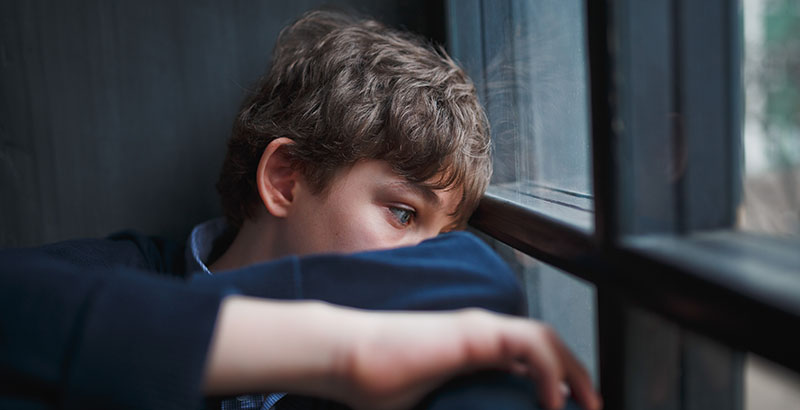A Parent’s Plea: After 18 Lonely Months of COVID, the Kids Are Not Alright. Here’s Why This Back-to-School Season Must Balance Learning With Healing

Get stories like these delivered straight to your inbox. Sign up for The 74 Newsletter
It felt like this fall would — at long last — be different.
Last March according to the National Center for Education Statistics, just short of 40 percent of U.S. students were still learning entirely remotely. Roughly the same percentage were back attending full-time in-person learning (another 23 percent of students were enrolled in hybrid learning).
Thanks to a steady stream of vaccines and some sorely overdue national public health leadership, it finally seemed like schools might be safe enough to push towards in-person reopening for most students this school year. And yet, the new Delta variant of the novel coronavirus has left the United States with uncertain prospects for in-person schooling this fall.
One thing is clear: families with young children are going to be stuck with mostly bad options this fall. Reopen schools even as pediatric infectious disease specialists warn us that the new variant of COVID-19 is a threat to our children? Keep schools mostly virtual as our collective mental health continues degrading? There’s stress, anxiety, suffering, and trauma down either route. The only certainty is that families and their kids are going to get another drubbing.
Think of it as a universal form of long COVID. Most of us, maybe all of us, whether or not we ever contracted the coronavirus, will carry some of this collective trauma along with us for years — perhaps for the rest of our lives. For our house, it’s the aches of aging parental bodies worn down by 18 (and counting) months of juggling two full-time jobs and full-time child care for three young kids. I’m also staggering into the post-pandemic period with a shattered sense of social trust after months of navigating our repeated collective failures to treat a generational crisis seriously.
I’m also carrying the solitary echoes of children shouting at one another from windows and porches last spring, pealing voices that bounced off the line of houses and down our block in a city frozen silent by the lockdown. Even when they were cheerful, the enveloping solitude was terrifying — a dystopian backdrop for an angry, anxious season.
The months wore on. These same kids would come up to me when I was out for furtive walks with our infant. They’d run over from lonely games and distracted, exhausted caregivers to ask about the kid in my stroller, and whether I knew about the school they attended before the virus, and had I noticed the stick tent they’d been building?
As you rush to jettison your masks, as you charge off on vacations, know that the kids are not alright. Some are traumatized, most are bearing significant daily stress, and almost all are lonely. Last fall, in a Parent Institute for Quality Education survey of Spanish-speaking families in California nearly two-thirds of respondents said that they were “concerned about their children’s emotional needs.” Food instability significantly increased for American kids during the pandemic, particularly children of color. Research on children and social isolation suggests that the impacts of this prolonged catastrophe won’t simply vanish with the end of lockdowns and the full reopening of schools.
That’s why educators must make children’s social and emotional well-being the lodestar this summer and fall — whether or not they can reopen safely. This won’t be easy in every community. Many administrators will, understandably, want to focus all of their energies towards academics. Data suggest that various pandemic learning models were not particularly effective for most kids: many schools will feel the pressure to reorganize their schedules around launching remediation programs or instructional strategies targeted at identifying the math (or reading, or science, or etc) skills kids missed last year … and then hurl their teachers into addressing these posthaste.
But in most cases, this will be a mistake both conceptual and tactical. First, it mistakes teaching and learning for simple, cumulative processes. High-quality instruction isn’t a matter of simply pouring knowledge into kids like water into a bucket. It’s a process of conversing and connecting, of working out what a child knows and what they don’t, determining what they care about and what they’re afraid of — and then drawing them from that place into new material. Kids learn best when they feel safe enough in their classroom and school communities to explore and take risks. In essence: all learning is both social and emotional.
Second, schools who scramble their pandemic recovery efforts around chasing students’ “learning loss” risk ignoring the depths of social and emotional challenges kids are likely to be carrying back to campus. A narrow focus on triaging students’ academic needs is unlikely to be as efficient as it might seem.
Whenever schools bring back their full student bodies for in-person learning, most will find that kids won’t come back fully whole. They won’t be immediately prepared to launch into aggressive, intensive academic instruction. They’ll return out of practice in, well … everything. They’ll need time to get used to focusing on learning in the presence of friends, spending whole days indoors around crowds, working within the educational structures of schedules and authority. Students need practice learning to be in communities with their teachers and peers.
Educators need to start there: to help kids reacclimate to the basics of spending their days living and learning in groups with their peers. This means giving children time to reconnect in organic, authentic ways with both kids and adults. It means making space to nudge kids into talking about how they’re feeling, about the struggles and challenges of the pandemic so that they don’t carry all of those stresses with them through the school year. And it means starting with informal activities that make reopening feel like the celebration and slow path back to normalcy that it should be. Critically, as they ease kids back into the routines of daily school, educators and administrators should be watching for red flags from those who may be suffering from trauma and other adverse childhood experiences.
This is one more instance of a pandemic lesson that’s worth carrying into the future: for more than a year, so many of us have repeatedly had to learn the hard way that we can’t set the terms for rushing back to normal. Over and over, we’ve tried to hurry past the serious work of leaving the crisis behind, and we’ve kept finding that there are consequences for skipping steps. School reopening is no different: we can take kids out of pandemic lockdown and back to school, but that doesn’t mean that the pandemic is done affecting kids.
Get stories like these delivered straight to your inbox. Sign up for The 74 Newsletter


